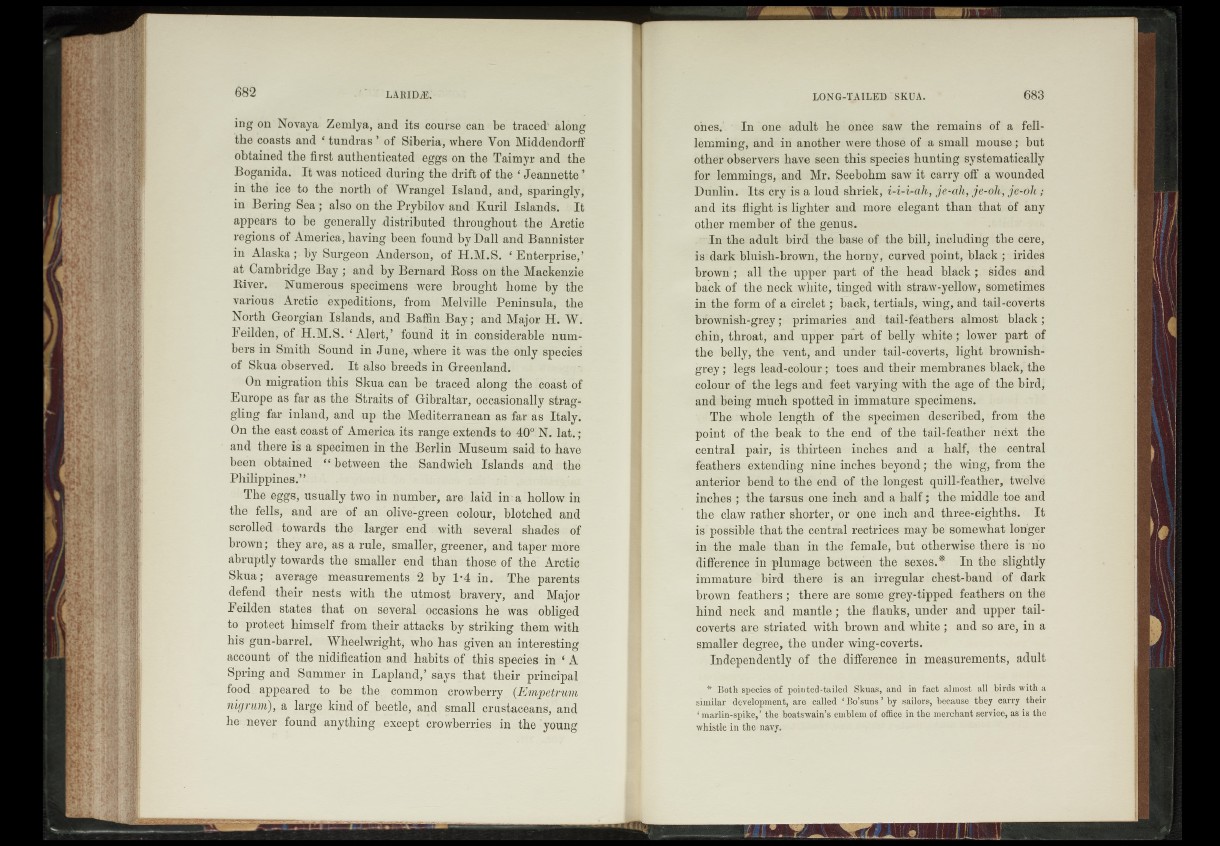
ing on Novaya Zemlya, and its course can -be traced' along
the coasts and ‘ tundras ’ of Siberia, where Von Middendorff
obtained the first authenticated eggs on the Taimyr and thé
Boganida. It was noticed during the drift of the i Jeannette *
in the ice to the north of Wrangel Island, and, sparingly,
in Bering Sea ; also on the Prybilov* and Kuril Islands. It
appears to be generally distributed throughout < thé Arctic
regions of America, having been found’by Ball and Bannister
in Alaska;, by Surgeon Anderson, of H.M.S. ^Enterprise?
at Cambridge Bay; and by Bernard B-oss on the .Mackenzie
River. Numerous Specimens ■ were 1 brought home by the
various Arctic expeditions, from Melville Peninsula, the
North Georgian Islands, and Baffin Bay; and Major \H. W.
Feilden, of H.M.S?* Alert,’ found it in, considerable' numbers
in Smith Sound in June, .where it was- the only species
of Skua observed/ It also breeds in Greenland.
On migration this Skua can be traced along the .coast of
Europe as far as the Straits of Gibraltar, 'occasionally strag-.
gling far inland, and up the Mediterranean as farras Italy.
On the east coast of America its range extends to 40°?N; laL;
and there is a specimen in the Berlin Miiseum said to have
been obtained “ between the . Sandwich Islands and . the
Philippines?*
The eggs, usually two in number, are laid in:a?hollow, in
the fells, and are of an olive-green colour, blotched and
scrolled i towards the larger end . with several shades | of
brown; they are; as a rule, smaller;greener, and taper more
abruptly towards the smaller end than • those of the' Arctic
Skua; average measurements 2 b y '1*4 in. The parents
defend their nests with the utmost bravery, and Major
Feilden states that on several- occasions. he was obliged
to protect himself from their attacks by striking them with
his gun-barrel. Wheelwright, who has-given an interesting
account of the nidification and habitsiof this species in ï- A
Spring and Summer in Lapland? says that .thèir principal
food, appeared to be the. common crow-berry,;(Empetrum
nigrum), a Jajge kind of .beetle, and small crustacean’s, and
he> never found anything except crowherries in the ‘young
ones? ' In ?one adult he once saw the remains of. a i felllemming,
and in another were those of a small mouse ; but
other observers have seen this species hunting systematically
for lemmings, and Mr. Seebohm saw’ it carry off a wounded
Dunlin. Its cry is a loud shriek, i-i-v-ah, je-ah,'je-ohi,’ j»-ôh }
and its flight; is. lighter and more elegant than that of any
other member of the genus.
. In the adult bird the base of thé bill, including ; the cere,
is dark bluisb-brown,the hörnfpeurved point, black ; virides
brown ; s'alh the upper part of the- head black ;. sides- and
back of the neck white, tinged with straw-yellow, sometimes
in the form of a circlet ; back, tertialsj wing, and- tail-coverts
brownish*grey ; primaries and tail-feathers almost black ;
chin, throat, and upper part of belly white; lower part of
the belly,-the vent, and under tail-:èövei&s,~ light brownish*
grey ; legs lead'^cdour ; toes and their membranes black, the
colour of Jhe legs ;and feet varying With the age of the bird?
and being much spotted in immature specimens.
■ The whole length i of? the; specimen described, from the
point;of-the beak to-the end of the taU-feaitihef next Ä i
central pair; -is thirteen inches and a half?- -the? central
feathers j extending nine inches beyond; >he wing, from the
anterior, bend to the end of the longest qui 11-feather, twelve
inches ;' the tarsus one inch and whalf ; the middle toe and
the claw rather shorter, or one inch- and three-eighths. It
isi’possible that the centjfcd rectri-ces may be somewhat longer
in the male than in-the; female, but otherwise, there is ‘no
difference -in plumage ^between the sexes.* IntheTALiÿhtly
immature?'bird theie is an irregular chest-bandi of dark
brown feathers ; there are some -grey-tipped ■ feathers on the
h i n d a n d mantle ; the- flanks, under and upper tail-
coverts are striated with brown and white ; and so are, in a
smaller degree,:lbë under wing-coverts.
Independently of the difference in meagurements, adult
* Both species of-pointed-tailed Skuas, and "in fae,t almost - all with a
similar development, are^calj^L ‘ Bo’suns ’ by, sailers, feepâfflSe they carry their
‘ marlin-spike,’?the boatswain’s eso-bleaLOf office in the merchant servi®, as is the
whittle in the»navy*î